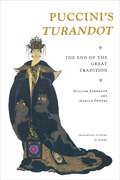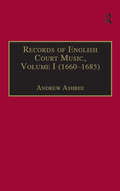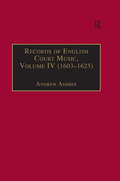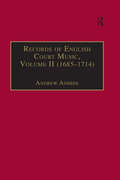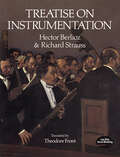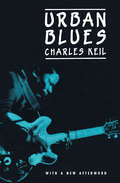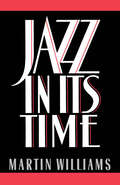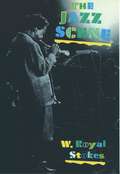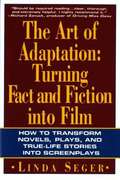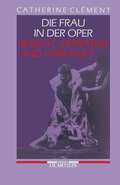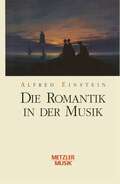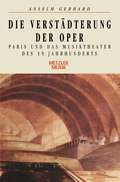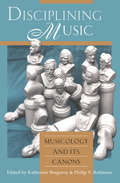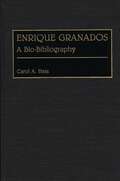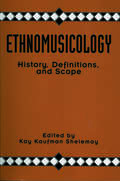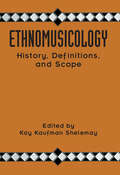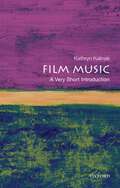- Table View
- List View
Puccini's "Turandot": The End of the Great Tradition
by William Ashbrook Harold PowersUnfinished at Puccini's death in 1924, Turandot was not only his most ambitious work, but it became the last Italian opera to enter the international repertory. In this colorful study two renowned music scholars demonstrate that this work, despite the modern climate in which it was written, was a fitting finale for the centuries-old Great Tradition of Italian opera. Here they provide concrete instances of how a listener might encounter the dramatic and musical structures of Turandot in light of the Italian melodramma, and firmly establish Puccini's last work within the tradition of Rossini, Bellini, Donizetti, and Verdi. In a summary of the sounds, sights, and symbolism of Turandot, the authors touch on earlier treatments of the subject, outline the conception, birth, and reception of the work, and analyze its coordinated dramatic and musical design. Showing how the evolution of the libretto documents Puccini's reversion to large musical forms typical of the Great Tradition in the late nineteenth century, they give particular attention to his use of contrasting Romantic, modernist, and two kinds of orientalist coloration in the general musical structure. They suggest that Puccini's inability to complete the opera resulted mainly from inadequate dramatic buildup for Turandot's last-minute change of heart combined with an overly successful treatment of the secondary character.
Puccini's Turandot: The End of the Great Tradition (Princeton Studies in Opera #30)
by William Ashbrook Harold PowersUnfinished at Puccini's death in 1924, Turandot was not only his most ambitious work, but it became the last Italian opera to enter the international repertory. In this colorful study two renowned music scholars demonstrate that this work, despite the modern climate in which it was written, was a fitting finale for the centuries-old Great Tradition of Italian opera. Here they provide concrete instances of how a listener might encounter the dramatic and musical structures of Turandot in light of the Italian melodramma, and firmly establish Puccini's last work within the tradition of Rossini, Bellini, Donizetti, and Verdi. In a summary of the sounds, sights, and symbolism of Turandot, the authors touch on earlier treatments of the subject, outline the conception, birth, and reception of the work, and analyze its coordinated dramatic and musical design. Showing how the evolution of the libretto documents Puccini's reversion to large musical forms typical of the Great Tradition in the late nineteenth century, they give particular attention to his use of contrasting Romantic, modernist, and two kinds of orientalist coloration in the general musical structure. They suggest that Puccini's inability to complete the opera resulted mainly from inadequate dramatic buildup for Turandot's last-minute change of heart combined with an overly successful treatment of the secondary character.
Records of English Court Music: Volume I (1660-1685)
by Andrew AshbeePioneering work on the musical material from the archives of the English court was undertaken by Nagel (1894), Lafontaine (1909) and Stokes (in the Musical Antiquary 1903-1913). Records of English Court Music (a series of seven volumes covering the period 1485-1714) is the first attempt to compile a systematic calendar of such references. It aims to revise these earlier studies where necessary, adding significant details which researchers omitted, clarifying the context of documents and substituting current call-marks for defunct references. Volume V is primarily concerned with the post-Restoration years already partially covered in volumes I and II. The material from the Exchequer and Declared Accounts of the Treasurer of the Chamber has been revised to include references to trumpeters and drummers. Other sections are devoted to material outside the Lord Chamberlain's papers: the Signet Office Docquet Books, Secret Service accounts and more from the Exchequer; the Corporation of Musick (controlled by the Court musicians) and to the range of music material from accounts of the Receivers General. Samples from the comprehensive records of the Lord Steward's department (including those of the Cofferer of the Household) are also provided. Andrew Ashbee was the winner of the Oldman Prize in 1987 for Volume II in the series of 'Records of English Court Music', awarded by the UK branch of the International Association of Music Libraries for the year's best book on music librarianship, bibliography and reference.
Records of English Court Music: Volume I (1660-1685)
by Andrew AshbeePioneering work on the musical material from the archives of the English court was undertaken by Nagel (1894), Lafontaine (1909) and Stokes (in the Musical Antiquary 1903-1913). Records of English Court Music (a series of seven volumes covering the period 1485-1714) is the first attempt to compile a systematic calendar of such references. It aims to revise these earlier studies where necessary, adding significant details which researchers omitted, clarifying the context of documents and substituting current call-marks for defunct references. Volume V is primarily concerned with the post-Restoration years already partially covered in volumes I and II. The material from the Exchequer and Declared Accounts of the Treasurer of the Chamber has been revised to include references to trumpeters and drummers. Other sections are devoted to material outside the Lord Chamberlain's papers: the Signet Office Docquet Books, Secret Service accounts and more from the Exchequer; the Corporation of Musick (controlled by the Court musicians) and to the range of music material from accounts of the Receivers General. Samples from the comprehensive records of the Lord Steward's department (including those of the Cofferer of the Household) are also provided. Andrew Ashbee was the winner of the Oldman Prize in 1987 for Volume II in the series of 'Records of English Court Music', awarded by the UK branch of the International Association of Music Libraries for the year's best book on music librarianship, bibliography and reference.
Records of English Court Music: Volume IV (1603–1625)
by Andrew AshbeePioneering work on the musical material from the archives of the English court was undertaken by Nagel (1894), Lafontaine (1909) and Stokes (in the Musical Antiquary 1903-1913). Records of English Court Music (a series of seven volumes covering the period 1485-1714) is the first attempt to compile a systematic calendar of such references. It aims to revise these earlier studies where necessary, adding significant details which researchers omitted, clarifying the context of documents and substituting current call-marks for defunct references. Volume V is primarily concerned with the post-Restoration years already partially covered in volumes I and II. The material from the Exchequer and Declared Accounts of the Treasurer of the Chamber has been revised to include references to trumpeters and drummers. Other sections are devoted to material outside the Lord Chamberlain's papers: the Signet Office Docquet Books, Secret Service accounts and more from the Exchequer; the Corporation of Musick (controlled by the Court musicians) and to the range of music material from accounts of the Receivers General. Samples from the comprehensive records of the Lord Steward's department (including those of the Cofferer of the Household) are also provided. Andrew Ashbee was the winner of the Oldman Prize in 1987 for Volume II in the series of 'Records of English Court Music', awarded by the UK branch of the International Association of Music Libraries for the year's best book on music librarianship, bibliography and reference.
Records of English Court Music: Volume II (1685 -1714)
by Andrew AshbeePioneering work on the musical material from the archives of the English court was undertaken by Nagel (1894), Lafontaine (1909) and Stokes (in the Musical Antiquary 1903-1913). Records of English Court Music (a series of seven volumes covering the period 1485-1714) is the first attempt to compile a systematic calendar of such references. It aims to revise these earlier studies where necessary, adding significant details which researchers omitted, clarifying the context of documents and substituting current call-marks for defunct references. Volume V is primarily concerned with the post-Restoration years already partially covered in volumes I and II. The material from the Exchequer and Declared Accounts of the Treasurer of the Chamber has been revised to include references to trumpeters and drummers. Other sections are devoted to material outside the Lord Chamberlain's papers: the Signet Office Docquet Books, Secret Service accounts and more from the Exchequer; the Corporation of Musick (controlled by the Court musicians) and to the range of music material from accounts of the Receivers General. Samples from the comprehensive records of the Lord Steward's department (including those of the Cofferer of the Household) are also provided. Andrew Ashbee was the winner of the Oldman Prize in 1987 for Volume II in the series of 'Records of English Court Music', awarded by the UK branch of the International Association of Music Libraries for the year's best book on music librarianship, bibliography and reference.
Records of English Court Music: Volume II (1685 -1714)
by Andrew AshbeePioneering work on the musical material from the archives of the English court was undertaken by Nagel (1894), Lafontaine (1909) and Stokes (in the Musical Antiquary 1903-1913). Records of English Court Music (a series of seven volumes covering the period 1485-1714) is the first attempt to compile a systematic calendar of such references. It aims to revise these earlier studies where necessary, adding significant details which researchers omitted, clarifying the context of documents and substituting current call-marks for defunct references. Volume V is primarily concerned with the post-Restoration years already partially covered in volumes I and II. The material from the Exchequer and Declared Accounts of the Treasurer of the Chamber has been revised to include references to trumpeters and drummers. Other sections are devoted to material outside the Lord Chamberlain's papers: the Signet Office Docquet Books, Secret Service accounts and more from the Exchequer; the Corporation of Musick (controlled by the Court musicians) and to the range of music material from accounts of the Receivers General. Samples from the comprehensive records of the Lord Steward's department (including those of the Cofferer of the Household) are also provided. Andrew Ashbee was the winner of the Oldman Prize in 1987 for Volume II in the series of 'Records of English Court Music', awarded by the UK branch of the International Association of Music Libraries for the year's best book on music librarianship, bibliography and reference.
Records of English Court Music: Volume IV (1603–1625)
by Andrew AshbeePioneering work on the musical material from the archives of the English court was undertaken by Nagel (1894), Lafontaine (1909) and Stokes (in the Musical Antiquary 1903-1913). Records of English Court Music (a series of seven volumes covering the period 1485-1714) is the first attempt to compile a systematic calendar of such references. It aims to revise these earlier studies where necessary, adding significant details which researchers omitted, clarifying the context of documents and substituting current call-marks for defunct references. Volume V is primarily concerned with the post-Restoration years already partially covered in volumes I and II. The material from the Exchequer and Declared Accounts of the Treasurer of the Chamber has been revised to include references to trumpeters and drummers. Other sections are devoted to material outside the Lord Chamberlain's papers: the Signet Office Docquet Books, Secret Service accounts and more from the Exchequer; the Corporation of Musick (controlled by the Court musicians) and to the range of music material from accounts of the Receivers General. Samples from the comprehensive records of the Lord Steward's department (including those of the Cofferer of the Household) are also provided. Andrew Ashbee was the winner of the Oldman Prize in 1987 for Volume II in the series of 'Records of English Court Music', awarded by the UK branch of the International Association of Music Libraries for the year's best book on music librarianship, bibliography and reference.
Treatise on Instrumentation
by Hector Berlioz Richard StraussThe most influential work of its kind ever written, appraising the musical qualities and potential of over 60 commonly used stringed, wind and percussion instruments. With 150 illustrative full-score musical examples from works by Berlioz, Mozart, Beethoven, Gluck, Weber, Wagner, and others, and numerous smaller musical examples. Complete with Berlioz' chapters on the orchestra and on conducting. Translated by Theodore Front. Foreword by Richard Strauss. Glossary.
Urban Blues
by Charles KeilCharles Keil examines the expressive role of blues bands and performers and stresses the intense interaction between performer and audience. Profiling bluesmen Bobby Bland and B. B. King, Keil argues that they are symbols for the black community, embodying important attitudes and roles—success, strong egos, and close ties to the community. While writing Urban Blues in the mid-1960s, Keil optimistically saw this cultural expression as contributing to the rising tide of raised political consciousness in Afro-America. His new Afterword examines black music in the context of capitalism and black culture in the context of worldwide trends toward diversification. "Enlightening. . . . [Keil] has given a provocative indication of the role of the blues singer as a focal point of ghetto community expression."—John S. Wilson, New York Times Book Review "A terribly valuable book and a powerful one. . . . Keil is an original thinker and . . . has offered us a major breakthrough."—Studs Terkel, Chicago Tribune "[Urban Blues] expresses authentic concern for people who are coming to realize that their past was . . . the source of meaningful cultural values."—Atlantic "An achievement of the first magnitude. . . . He opens our eyes and introduces a world of amazingly complex musical happening."—Robert Farris Thompson, Ethnomusicology "[Keil's] vigorous, aggressive scholarship, lucid style and sparkling analysis stimulate the challenge. Valuable insights come from treating urban blues as artistic communication."—James A. Bonar, Boston Herald
Urban Blues
by Charles KeilCharles Keil examines the expressive role of blues bands and performers and stresses the intense interaction between performer and audience. Profiling bluesmen Bobby Bland and B. B. King, Keil argues that they are symbols for the black community, embodying important attitudes and roles—success, strong egos, and close ties to the community. While writing Urban Blues in the mid-1960s, Keil optimistically saw this cultural expression as contributing to the rising tide of raised political consciousness in Afro-America. His new Afterword examines black music in the context of capitalism and black culture in the context of worldwide trends toward diversification. "Enlightening. . . . [Keil] has given a provocative indication of the role of the blues singer as a focal point of ghetto community expression."—John S. Wilson, New York Times Book Review "A terribly valuable book and a powerful one. . . . Keil is an original thinker and . . . has offered us a major breakthrough."—Studs Terkel, Chicago Tribune "[Urban Blues] expresses authentic concern for people who are coming to realize that their past was . . . the source of meaningful cultural values."—Atlantic "An achievement of the first magnitude. . . . He opens our eyes and introduces a world of amazingly complex musical happening."—Robert Farris Thompson, Ethnomusicology "[Keil's] vigorous, aggressive scholarship, lucid style and sparkling analysis stimulate the challenge. Valuable insights come from treating urban blues as artistic communication."—James A. Bonar, Boston Herald
Urban Blues
by Charles KeilCharles Keil examines the expressive role of blues bands and performers and stresses the intense interaction between performer and audience. Profiling bluesmen Bobby Bland and B. B. King, Keil argues that they are symbols for the black community, embodying important attitudes and roles—success, strong egos, and close ties to the community. While writing Urban Blues in the mid-1960s, Keil optimistically saw this cultural expression as contributing to the rising tide of raised political consciousness in Afro-America. His new Afterword examines black music in the context of capitalism and black culture in the context of worldwide trends toward diversification. "Enlightening. . . . [Keil] has given a provocative indication of the role of the blues singer as a focal point of ghetto community expression."—John S. Wilson, New York Times Book Review "A terribly valuable book and a powerful one. . . . Keil is an original thinker and . . . has offered us a major breakthrough."—Studs Terkel, Chicago Tribune "[Urban Blues] expresses authentic concern for people who are coming to realize that their past was . . . the source of meaningful cultural values."—Atlantic "An achievement of the first magnitude. . . . He opens our eyes and introduces a world of amazingly complex musical happening."—Robert Farris Thompson, Ethnomusicology "[Keil's] vigorous, aggressive scholarship, lucid style and sparkling analysis stimulate the challenge. Valuable insights come from treating urban blues as artistic communication."—James A. Bonar, Boston Herald
Urban Blues
by Charles KeilCharles Keil examines the expressive role of blues bands and performers and stresses the intense interaction between performer and audience. Profiling bluesmen Bobby Bland and B. B. King, Keil argues that they are symbols for the black community, embodying important attitudes and roles—success, strong egos, and close ties to the community. While writing Urban Blues in the mid-1960s, Keil optimistically saw this cultural expression as contributing to the rising tide of raised political consciousness in Afro-America. His new Afterword examines black music in the context of capitalism and black culture in the context of worldwide trends toward diversification. "Enlightening. . . . [Keil] has given a provocative indication of the role of the blues singer as a focal point of ghetto community expression."—John S. Wilson, New York Times Book Review "A terribly valuable book and a powerful one. . . . Keil is an original thinker and . . . has offered us a major breakthrough."—Studs Terkel, Chicago Tribune "[Urban Blues] expresses authentic concern for people who are coming to realize that their past was . . . the source of meaningful cultural values."—Atlantic "An achievement of the first magnitude. . . . He opens our eyes and introduces a world of amazingly complex musical happening."—Robert Farris Thompson, Ethnomusicology "[Keil's] vigorous, aggressive scholarship, lucid style and sparkling analysis stimulate the challenge. Valuable insights come from treating urban blues as artistic communication."—James A. Bonar, Boston Herald
Jazz in Its Time
by Martin WilliamsFrom record album liner notes to serious academic pieces, Martin Williams has been perceptively chronicling the development of jazz for over three decades. In this, his newest collection of jazz writings, Williams brings together many of his best pieces and covers new ground, with short columns on Teddy Wilson and George Winston and a longer article, "How Long Has This Been Going On?," examining the current state of jazz. In this last work, Williams notes that jazz is experiencing a period of "stylistic retrenchment or, if you will, a period of conservatism," and questions the fusion of jazz with rock. Williams cites the opinion of Wynton Marsalis and a number of other musicians, who "seem to see the whole fusion thing as a kind of commercial opportunism and artistic blind alley, maybe even a betrayal of the music." Arranged roughly according to the form of the writing (music reviews, profiles, etc.) the pieces included here examine the musicianship of jazz greats from Sidney Bechet to Ornette Coleman, including Lionel Hampton, Lee Konitz, Art Farmer, and others. There are also thought pieces on the development and direction of jazz and jazz scholarship. Together, these works provide an insightful overview of the development of jazz over the past twenty years.
The Jazz Scene: An Informal History from New Orleans to 1990
by W. Royal StokesNo one can tell us more about jazz than the musicians themselves. Unfortunately, most oral histories have limited scope--focusing on a particular era or style--and fail to capture the full, rich story of jazz. Now, in this vivid oral history, W. Royal Stokes presents nearly a century of jazz--its people, places, periods, and styles--as it was seen by the artists who created America's most distinctive music. Here, along with the author's enlightening commentary, are the words of musicians famous and little-known, veterans of the early years and pathbreakers of the present, telling us about their origins and adventures, about the places and performers they have known. We read of young artists learning their skills surrounded by poverty, going on to win fame around the world. We feel the excitement of jazz before the war ("The music was all over the place," recalled Wild Bill Davison. "It's just unbelievable how many bands there were in Chicago. You could go anywhere and there'd be a band."). And we glimpse the gritty, hard life hidden beneath the beauty of the notes they played: "I remember not eating practically a month several times," said Mary Lou Williams. "During the depression we played engagements and we knew we weren't going to get any money because Andy would scatch his face when he was walking toward the band and the trumpet player would pull out his horn and play the 'Weary Blues.' And we'd laugh about it. We hadn't eaten in a couple of days and nothing was said, because the music was our survival." Stokes not only uncovers the history of jazz in the major cities and regions--New Orleans, for instance, Chicago in the '20s and '30s, Kansas City, and California from the '50s to the present--but he goes on to bring us the story of the big bands, post-bebop developments, vocalists, jazz around the globe, and the contemporary scene ("I was about eleven and my brother Mike started to bring home a lot of Miles Davis records from school and that did it for me," remembers Pat Metheny. "First time I heard Miles playing 'My Funny Valentine,' that whole record just destroyed me."). And he takes a close look at the rising place of women as instrumentalists in the last decade. Jazz is America's most original contribution to music, and--as the late Dexter Gordon lamented--America is the one country where it is little known. But W. Royal Stokes uncovers a scene that is as alive as ever, with this fascinating look at how it has been made and remade from the first decades of the century to today.
The Art of Adaptation: Turning Fact and Fiction into Film (PDF)
by Linda SegerAdaptations have long been a mainstay of Hollywood and the television networks. Indeed, most Academy Award- and Emmy Award-winning films have been adaptations of novels, plays, or true-life stories. Linda Seger, author of two acclaimed books on scriptwriting, now offers a comprehensive handbook for screenwriters, producers, and directors who want to successfully transform fictional or factual material into film. Seger tells how to analyze source material to understand why some of it resists adaptation. She then gives practical methods for translating story, characters, themes, and style into film. A final section details essential information on how to adapt material and how to protect oneself legally
Disciplining Music: Musicology and Its Canons
by Katherine Bergeron Philip V. BohlmanProvocative and timely, Disciplining Music confronts a topic that has sparked considerable debate in recent years: how do musicians and music scholars "discipline" music in their efforts to confer order and meaning on it? This collection of essays addresses this issue by formulating questions about music's canons—rules that measure and order, negotiate cultural constraints, reconstruct the past, and shape the future. Written by scholars representing the fields of historical musicology, ethnomusicology, and music theory, many of the essays tug and push at the very boundaries of these traditional division within the study of music. "Fortunately, in a blaze of good-humored . . . scholarship, [this] book helps brains unaccustomed to thinking about the future without jeopardizing the past imagine the wonder classical-music life might become if it embraced all people and all musics."—Laurence Vittes, Los Angeles Reader "These essays will force us to rethink our position on many issues. . . [and] advance musicology into the twenty-first century."—Giulio Ongaro, American Music Teacher With essays by Katherine Bergeron, Philip V. Bohlman, Richard Cohn and Douglas Dempster, Philip Gossett, Robert P. Morgan, Bruno Nettl, Don Michael Randel, Ruth A. Solie, and Gary Tomlinson.
Enrique Granados: A Bio-Bibliography (Bio-Bibliographies in Music)
by Carol A. HessEnrique Granados (1867-1916) was one of the first modern Spanish composers to achieve international recognition. During a 1916 visit to the United States his opera Goyescas was premiered by the Metropolitan Opera and his symphonic poem, Dante, by the Chicago Symphony. Granados was also especially admired in Paris, where he knew Saint-Saens, d'Indy, and Faure. He had composed a remarkable body of work and was also at the height of his career as a concert pianist at his untimely death while a passenger on a torpedoed British ship.The biographical study, the first in English, draws on primary sources in English, Spanish, French, Catalan, and other languages. This material is carefully documented in the extensive annotated bibliography along with contemporaneous and recent analytical studies and other sources. Granados's oeuvre presents cataloging problems due to his habit of reworking pieces, long-delayed publication, and arbitrary opus numbers. In the Works and Performances section, however, every effort has been made to offer publication dates, manuscript locations, and information on premieres. Representative arrangements of his works by other composers are also given. An appendix classifies the works by scoring. A selective discography is also provided, and all parts of the volume are fully cross-referenced and indexed. Granados is placed in the context of the international artistic scene at the turn of the century, and a chronology notes related events.
Ethnomusicology: History, Definitions, and Scope: A Core Collection of Scholarly Articles
by Kay Kaufman ShelemayFirst Published in 1992. Routledge is an imprint of Taylor & Francis, an informa company.
Ethnomusicology: History, Definitions, and Scope: A Core Collection of Scholarly Articles
by Kay Kaufman ShelemayFirst Published in 1992. Routledge is an imprint of Taylor & Francis, an informa company.
Film Music: Music And The Classical Hollywood Film (Wisconsin Studies In Film Ser.)
by Kathryn KalinakFilm Music: Music And The Classical Hollywood Film (Very Short Int)
by Kathryn KalinakFilm music is as old as cinema itself. Years before synchronized sound became the norm, projected moving images were shown to musical accompaniment, whether performed by a lone piano player or a hundred-piece orchestra. Today film music has become its own industry, indispensable to the marketability of movies around the world. Film Music: A Very Short Introduction is a compact, lucid, and thoroughly engaging overview written by one of the leading authorities on the subject. After opening with a fascinating analysis of the music from a key sequence in Quentin Tarantino's Reservoir Dogs, Kathryn Kalinak introduces readers not only to important composers and musical styles but also to modern theoretical concepts about how and why film music works. Throughout the book she embraces a global perspective, examining film music in Asia and the Middle East as well as in Europe and the United States. Key collaborations between directors and composers--Alfred Hitchcock and Bernard Herrmann, Akira Kurosawa and Fumio Hayasaka, Federico Fellini and Nino Rota, to name only a few--come under scrutiny, as do the oft-neglected practices of the silent film era. She also explores differences between original film scores and compilation soundtracks that cull music from pre-existing sources. As Kalinak points out, film music can do many things, from establishing mood and setting to clarifying plot points and creating emotions that are only dimly realized in the images. This book illuminates the many ways it accomplishes those tasks and will have its readers thinking a bit more deeply and critically the next time they sit in a darkened movie theater and music suddenly swells as the action unfolds onscreen. About the Series: Combining authority with wit, accessibility, and style, Very Short Introductions offer an introduction to some of life's most interesting topics. Written by experts for the newcomer, they demonstrate the finest contemporary thinking about the central problems and issues in hundreds of key topics, from philosophy to Freud, quantum theory to Islam.
